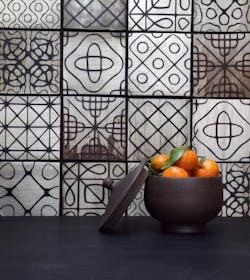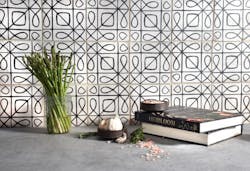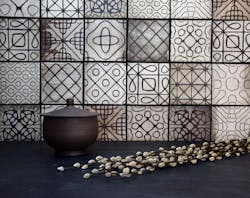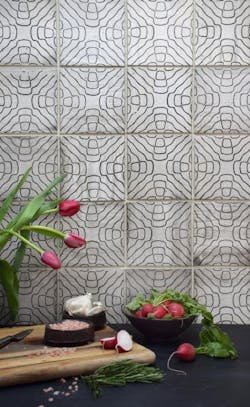California-based tile brand FLM Ceramics has introduced a new handcrafted series that mimics sound-wave patterns.
Drawing inspiration from 18th century sound experimentation by physicist Ernst Chladi, the Sound Wave series consists of 12 ceramic tile designs measuring 6 inches by 6 inches. It also comes in two colorways, Cast Iron and Inverted Cast Iron.
Hand-crafted and designed by potter, tile maker, and educator Forrest Lesch-Middelton, each Sound Wave tile design in this series is named for the unique frequency the plate was tuned to when the pattern appeared, or relates to the number Ernest Chladni assigned to the pattern, the company says. “Forrest is the only ceramicist to apply Chladni's sound wave patterns to the creation of tile,” the company adds.
[ Read More: Dutch Tile Maker Mosa Releases Ocean-Inspired Artisanal Wall Collection ]
“It was while he was at Northern Clay Center in Minneapolis on a McKnight Fellowship that Forrest developed the tile,” the company says in a release announcing the line. “He borrowed the equipment from the University of Minnesota physics department to research the effects of sound waves on pattern. Chladni’s work in the 18th century became the catalyst that bridged the gap between idea and object. Forrest had already mined history for his first tile collection and wanted to go beyond the cultural history of pattern and look toward the deeper human and metaphysical connections that inspired the origins of pattern.”
In the Chladini experiments, frequencies were introduced to a steel plate balanced on top of a tone generator that when dusted with sand, creates unique patterns through tonal vibrations. The tile designs echo some of these patterns.
[ Read more: What Is the Difference Between Red-Body and White-Body Ceramic Tile? ]
"As a tile maker I am limited physically by my equipment, as a thinker I am only limited by my mind,” Lesch-Middelton says. “It took me years to find the time and equipment to justify the research needed to develop the Sound Wave tiles. Once the research was complete I felt a great deal of satisfaction. The idea for these tiles came like a bolt out of the blue, and I feel as if I will never stop being curious about the meaning behind it. The sounds that create the patterns range greatly, from incredibly deep resonant tones to shrill ear-splitting pitches that literally had dogs in the neighborhood barking as I was running the tests. Visually the patterns are incredibly subjective, the interpretation of the visual language is up to the viewer's own experiences, that is the beauty and ambiguity of these patterns."
FLM explains that once Lesch-Middelton had access to the Chladni plates he experimented for eight weeks before attempting to add clay to the mix. The process involved replacing the original steel with a wafer thin porcelain plate made with porcelain slip and using a tone generator to create patterns by sifting ceramic pigments (instead of sand) over the porcelain.
[ Read More: Walker Zanger Unveils A New Collection of Terra Cotta Tiles ]
“Once finished, the porcelain plates were kiln fired to permanently affix the patterns,” the company explains. “Finally, a photo was taken and digital versions of each pattern were created to make the silkscreens necessary for creating multiples of each design.”
Tiles are sold individually and can be composed with either a tessellated repeat or a variegated composition. The company says they are heat resistant and can be installed indoors or outdoors on vertical surfaces and floors with light to medium traffic.
Sound Wave tiles are available exclusively at FLM Ceramics: flmceramics.com
[ Read More: Designer Sasha Bikoff, New Ravenna Release Sweeping New Tile Collection ]




